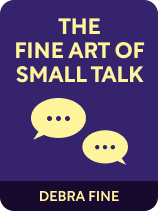

This article is an excerpt from the Shortform book guide to "The Fine Art of Small Talk" by Debra Fine. Shortform has the world's best summaries and analyses of books you should be reading.
Like this article? Sign up for a free trial here .
How do you introduce yourself to someone you don’t know? Why is learning someone’s name so important?
Debra Fine, small talk expert, provides the following advice for introducing yourself to a stranger: choose a partner who is open to conversation, make eye contact, and learn their name immediately. There are also signals you can look for to tell whether or not the person wants to talk to you.
Here’s Debra Fine’s advice on how to introduce yourself.
Indroductions
The first step of conversation is making an initial connection with another person. Let’s explore how to choose a partner, introduce yourself to someone, and learn their name.
Choose a Partner and Introduce Yourself
Before you can start a conversation, you have to find someone to have that conversation with. When choosing someone to talk to, Fine recommends the following two-step process:
1. Scan the room and find someone who’s on their own, who’s not engaged in a conversation or an activity, and who makes eye contact with you.
(Shortform note: There are far more signals that someone doesn’t want to talk than Fine lists: Leave people alone if they’re wearing headphones, reading, crossing their arms or showing other “closed” body language, or if they turn away from you when you look at them.)
2. When you make eye contact, smile at the person. Fine explains that this shows the other party you’re interested in them and immediately establishes a rapport. When you smile at someone, their natural response is to smile back; right off the bat, the two of you share a positive feeling.
(Shortform note: Fine’s principle assumes that the other person will smile back; but what if they don’t? Is trying to connect then a lost cause? Probably: Research indicates that a genuine smile communicates a desire to engage cooperatively and altruistically. We can reverse this to imply that someone who doesn’t genuinely smile back doesn’t want to cooperate and converse with you.)
How to Introduce Yourself and Learn Their Name
Once you’ve chosen a conversational partner and established rapport through a smile, walk up to them, Fine suggests, make eye contact, smile again, and shake their hand.
(Shortform note: Fine suggests handshaking because, in Western society, it’s the polite thing to do—but you don’t have to do it. In fact, many people choose not to for hygiene reasons: Doctors have argued for years that handshaking is unhygienic. Furthermore, according to the CDC, 69% of men admit that they don’t always wash their hands after using the bathroom, making shaking those hands an unpleasant prospect. If you don’t want to shake hands, the Harvard Business Review recommends you communicate warmth, friendliness, and respect in another way, such as by offering a small bow.)
Say, “Hi. My name is…” Then, stay focused as the other person returns the introduction. Remember their name and use it immediately: For instance, say “Nice to meet you, Albert!” If you miss a person’s name, Fine recommends asking them to repeat it. Remember that everyone has the right to be called by their name, she notes, and that those with difficult names will appreciate it.
(Shortform note: It’s not just people with difficult names who’ll appreciate your efforts: According to Dale Carnegie, everyone is thrilled when someone learns and uses their name. Carnegie argues that a person’s name is the most important word in any language to them—saying it is a subtle and welcome compliment. In contrast, forgetting a name or getting it wrong suggests you didn’t care enough to get it right. Use a person’s name often, he says, and respect it.)
Relatedly, when you meet someone whose name you’ve forgotten, Fine suggests asking for it right away. Don’t compound the awkwardness by being unable to introduce them in the future.
(Shortform note: A word of caution: People can be especially unforgiving of those who forget their names. If you follow Fine’s advice, don’t be surprised if the person whose name you have to ask for is annoyed at you.)
| How to Remember Names Fine makes it clear that remembering someone’s name is a crucial part of conversing successfully, but doesn’t provide many strategies for name memorization. If you find remembering names exceptionally difficult, try the following tricks: As well as repeating the name immediately, pepper it into the conversation. The more we use a name, the more likely we are to remember it. Further, say the name again before you leave; doing so aids retention. Find something unique about the person’s face and focus on it when you say their name: The more context you can add to your memory of the name, the better. It’s easier to remember the name of “Andy with the big nose” or “Roxanne with the pointy red glasses,” than just “Andy” or “Roxanne.”Ask the person to spell their name to drag out the amount of time you spend focused on it. Find out if it’s “Sarah with an H,” or “Sara with no H.” Create a mental image associating their name with a visual. For example, imagine your new friend Holly standing under a Christmas tree, or put Einstein’s hair on Albert’s head. Memory champions—like Boris Konrad, who used this technique to memorize 195 names and faces in 15 minutes—say practice is all it takes to master this skill. |

———End of Preview———
Like what you just read? Read the rest of the world's best book summary and analysis of Debra Fine's "The Fine Art of Small Talk" at Shortform .
Here's what you'll find in our full The Fine Art of Small Talk summary :
- Why we need small talk and why we shouldn't avoid it
- How to appear confident and engaging in any context
- How to break the ice with strangers and keep the conversation going






